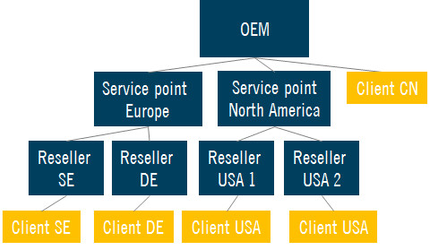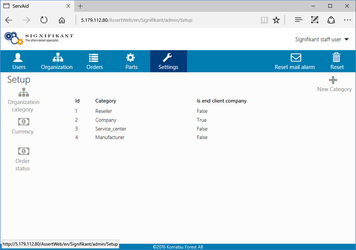...
Users may belong to a company. This is typically used for users working at that particular company. For users connected to a company the following will apply:
Users at a company will see orders from other users in that company.
Orders placed by a user at a company will be directed to the reseller of that company (rather than the reseller of an user).
If the user has permissions to access CompanyAdministration function, the user will be able to add new users, remove users and change permissions of users at that company.
Organisations may be structured in a hierarch and categorized. The available categories may be changed.
Categories are typically Company (end users are connected to companies), Resellers (may accept orders from users/companies), Service point (e.g. a manufacturer's local company) Manufacturer (may accept orders from users/companies).
Companies may be assigned a parent company. The parent company will control the hierarcy, e.g. several Resellers in a country will have the local Service point as parent company. Orders placed by the Reseller will get directed to the Service point.
Organisations
The purpose of the organisations function is to build a service and reseller structure, e.g. as the structure below.
Organisations created with this information:
Parent organisation - specifies the organisation above in the hierarchy.
Accept orders - specifies if an end client can select the organisation as a reseller.
In the sample below, OEM, Reseller SE, Reseller DE, Reseller USA1 and Reseller USA2 all have "Accept orders"
...
Manage categories
The available categories are defined in the settings area. Sample categories are Manufacturer, Service Point, Reseller, Customer.
One category may be marked with "Is end client company". This will control which category is used when an end user registers.
| Info |
|---|
Note that it is not possible to select an organisation which is an end customer as a parent organisation. So ensure to check category of the organisations before setting up a hierarchy. |
...
Users
Users may be connected to a reseller and, if organisations function is on, to a company.
...
An user with permission to administer a company ("CompanyAdministration" resource) may invite new users to that company and change permissions on these users. If an user registers a company, that user will automatically get credentials to administer that company.
...
Configuration
Turn on organisations function using these
...
settings.
profile.config
| Code Block | ||
|---|---|---|
| ||
<!-- Turn on organisation function --> <OrganizationEnabled>true</OrganizationEnabled> To enable users to become company administrators, the below resource will need to be added to a user group. <ResourcePermission> |
Permissions
| Code Block | ||
|---|---|---|
| ||
<ResourcePermission> <Id>4</Id> <Enabled>true</Enabled> <Name>CompanyAdministration</Name> <Note>Administrate Company and users of the company</Note> |
Related articles
| Filter by label (Content by label) | ||||||||||
|---|---|---|---|---|---|---|---|---|---|---|
|
...
|
| Page Properties | ||
|---|---|---|
| ||
|

